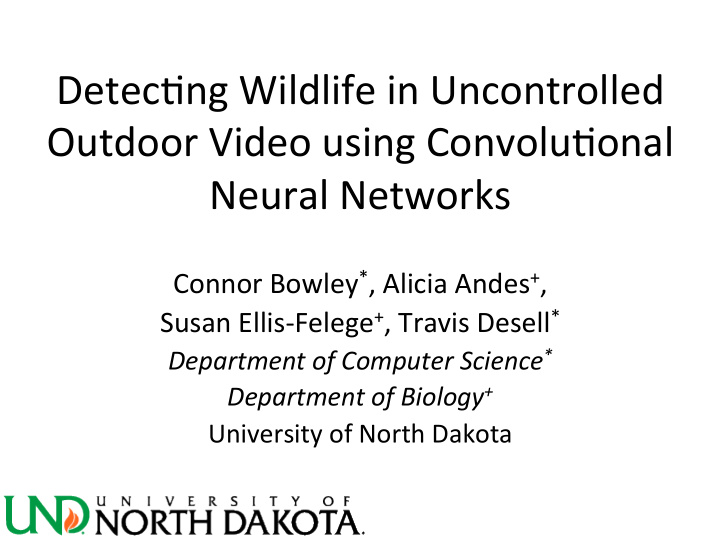



Detec%ng Wildlife in Uncontrolled Outdoor Video using Convolu%onal Neural Networks Connor Bowley * , Alicia Andes + , Susan Ellis-Felege + , Travis Desell * Department of Computer Science * Department of Biology + University of North Dakota
Wildlife@Home • Ci%zen Science project combining crowd sourcing and volunteer compu%ng. • Users can examine videos and images and record what happens • They can also volunteer their computer to download videos and run algorithms over them • There is a web portal to compare results from the users, experts, and computer vision algorithms
Wildlife@Home • Nest cameras • Around 7.8 years of video %me gathered over 3 years – Over 91,000 videos of Grouse, Interior Least Tern, and Piping Plover – A liZle over 4.5 TB • Challenges with dataset – Changing weather – Changing ligh%ng as day progresses, cloud cover – Some species are camouflaged – Video quality can be low
Crowd sourcing interface users can give us informa%on about the video through. The biology experts have a similar interface.
Convolu%onal Neural Networks • CNNs commonly used for image classifica%on • A few types of layers – Convolu%onal (has weights to be trained) – Ac%va%on – Max Pooling – Fully Connected hZp://cs231n.github.io/assets/cnn/cnn.jpeg • Socmax or SVM usually used at the end • Local connec%ons, shared weights • Learns from labeled training data
Crea%ng Training Data • Images of variable sizes • Sub-images size 32x32 used for training • Striding process used to get sub-images • Careful cropping needed to minimize mislabeled data
Crea%ng Training Data • Images of variable sizes • Sub-images size 32x32 used for training • Striding process used to get sub-images • Careful cropping needed to minimize mislabeled data
Crea%ng Training Data • Images of variable sizes • Sub-images size 32x32 used for training • Striding process used to get sub-images • Careful cropping needed to minimize mislabeled data
Crea%ng Training Data
Crea%ng and Training CNN • WriZen in C++ and OpenCL – C++ allows distribu%on via BOINC – OpenCL allows execu%on on most CPUs and GPUs • Stochas%c gradient descent backpropaga%on • Uses L2 regulariza%on and Nesterov Momentum • Weights ini%alized by normal distribu%on with 1 mean of 0 and standard devia%on of 2 / n • Two way socmax classifier – (tern not in frame, tern in frame) 1 hZp://cs231n.github.io/neural-networks-3/
Crea%ng and Training CNN In total 2068 weights
Running the Trained CNN • Strided over full images similar to method used to create training data • A predic%on image is created for each frame in video to create a predic%on video • A chart is also created ploing how much of each frame is predicted to be of the posi%ve class
Running the Trained CNN • Each pixel in full image has a “pixel classifier” – Socmax output in sub-image is added into pixel classifier of each pixel in sub-image • Sub-images may overlap and their outputs are summed into pixel classifier • Pixel color determined using ra%o of squares of pixel classifier – red is posi%ve class, blue is nega%ve class
Results • Ini%ally trained 5 epochs over ~73,000 images from 1 video • Ended training with accuracy of 95.6% on training data • Run over test set of 280,000 images from 2 other videos with 82% accuracy – These images were not created yet during ini%al training – Videos all from same nest, so some background images might have been similar – 77% of errors from false posi%ves
Results Original Image Acer Ini%al Training
Extra Training • Misclassifica%on prompted extra training on CNN • New training set of approx. 17,000 images – 69% nega%ve – Mostly of trees and ground stubble – Posi%ve examples were reused from original training set
Original Image Acer Ini%al Training Acer 2 extra epochs Acer 4 extra epochs
Predic%on Video
Tracking when a tern is in the frame • Charts were made tracking how much of the image is comprised of red (posi%ve class) pixels • Easy to see some trends across whole video • Difficult to classify frame by frame • Difficult to classify more complex events
Results of Running Trained CNN over Simple Video
Results of Running Trained CNN over More Complex Video
Improving Performance • Many computers have mul%ple OpenCL capable devices. – Exp. A CPU and a GPU • Run%me performance can be increased by using mul%ple devices simultaneously • Some devices may be faster or slower than others
Improving Performance • Work stealing approach • Copy of CNN on each device • Each device requests one frame at a %me from Video manager • Once finished, the results are submiZed to Output manager – Frames that come out of order are buffered un%l they are next to be outpuZed
Performance Results
Future Work • Get more training data – Grouse and Piping Plover – Crowd source crea%on of training data • Full implementa%on with BOINC for distributed running over en%re dataset • Larger sizes than 32x32 • Speed improvements to CNN code since submission warrant tes%ng of larger networks • BeZer algorithms to determine if frames contain wildlife or if it is noise – CNN over output? – Blob detec%on on output?
Resources • Code on Git – hZps://github.com/Connor-Bowley/ neuralNetwork – Commit 8d95bf087cde7483c4984fc4891778f5280381fc (May 24, 2016) • Videos available via Wildlife@Home Data Release – hZp://csgrid.org/csg/wildlife/data_releases.php
Acknowledgements We appreciate the support and dedica%on of the Wildlife@Home ci%zen scien%sts who have spent significant amounts of %me watching video. This work has been par%ally supported by the Na%onal Science Founda%on under Grant Number 1319700. Any opinions, findings, and conclusions or recommenda%ons expressed in this material are those of the authors and do not necessarily reflect the views of the Na%onal Science Founda%on. Funds to collect data in the field were provided by the U.S. Geological Survey.
Thanks! Ques%ons? hZp://csgrid.org/csg/wildlife connor.bowley7@gmail.com
Recommend
More recommend